 If orange road construction barrels are the unofficial tree in some U.S. states, then cranes are the unofficial bird of China.
The routes into both Beijing and Xi'an were lined by apartment and office towers of the future in various stages of construction.
On the way to see the Terracotta Warriors east of Xi'an on Friday, I lost count of the number of buildings with tower cranes around 86. Then we passed another flock of at least a dozen shells of buildings, and I gave up.
It is as if the bones of China's major cities are experiencing hyper-fast growth spurts at the same time.
And that got me wondering about a few things.
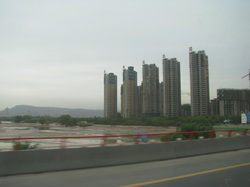 1. Who the heck is building all of these apartments and condos? Independent information, especially about the economy, isn't easy to find in China. But I was able to verify that the China Housing and Land Development Corp. Inc. is the largest non-governmental residential construction company in Xi'an. And it has been racing over the past five years to get ahead of an increase in housing demand to satisfy China's burgeoning middle class. But there's also money to be made -- either now or in the future. And that has gotten the attention of China's nuveau riche. 2. Who buys all these condos? And the answer might be not a lot of people ... yet. Our guide at the Terracotta Warriors said that wealthy Chinese are investing in these condos now in preparation for the next wave of massive migration of Chinese from the country to the cities. So that's why it doesn't seem to matter that many of the new buildings have vacant condos, according to Kate's Chinese friends. Indeed, real estate development investment increased nearly ten-fold between 2001 and 2010, from $75 billion to nearly $730 billion, according to the China Housing and Land Corp. One other related note: The Chinese government did implement a rule barring foreigners and Chinese from purchasing more homes beyond the one they live in so as to limit property speculation. That started in 2010 as a way to keep home prices from spiraling beyond the grasp of the new middle class and to slow inflation, according to this China-Briefing article. 3. Finally, where the heck are all these cranes coming from?
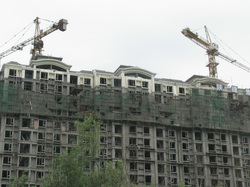 Most of them are coming from China. The domestic tower crane manufacturing here is seeing an increase in production capacity "of a magnitude unparalleled in the history of the crane industry," according to Stuart Anderson, who toured eight crane factories earlier this year for Crane Today Magazine (yes, that's a real thing.) Demand for use in China is fueling 90 percent of that production, he wrote. So yes, apparently cranes can fly after all. - Ryan
 The restaurant: Xiao Yang Barbecue. The restaurant: Xiao Yang Barbecue. The two main things we look for in restaurants here are whether they are cooking and selling their food inside (we suspect it greatly increases the chances that somebody is inspecting them) and whether they have pictures on the menu. It's a leap of faith after that.
Kate, who gave us that advice, took us to a Chinese barbecue joint Thursday night. And we ordered ourselves our own personal Chinese buffet of grilled, seasoned, noodled, skewered, roasted, steamed and barbecued vegetables.
Some useful information Kate shared: Restaurants bring out the food in the order in which it is done. So food that we ordered seemed to keep arriving. And the custom is to order more food than can be eaten at one sitting. That, Kate said, stems from the hosts to provide enough that no guests leave hungry. "A clean plate isn't a good thing," Kate said. That also means the doggie-bag business is booming at restaurants.
First came the Lotus fruit and peanuts, which we realized later when we were doggie-bagging it also came on top of noodles.
After that came a selection of skewered barbecue Shitake mushrooms, barbecued green beans, steamed broccoli, cauliflower, tofu and squid on skewers, woodear mushrooms (whose name doesn't give them justice) with celery-like greens, vegetable rolls with spicy dipping sauce, spicy eggplant and bread and bean dip.
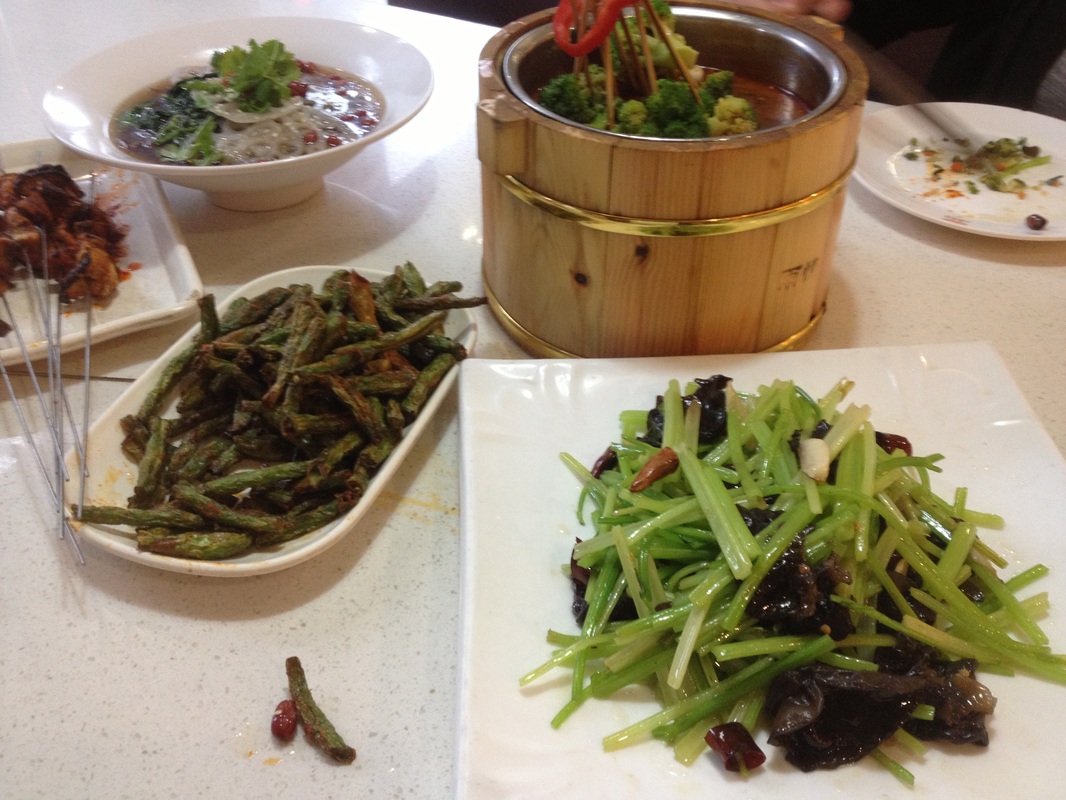 Part of our vegetable feast. Our waitress spoke zero English, so Kate handled most of the ordering, except she let me order several of the dishes by pointing to the picture and saying "This" in Mandarin, which is "zhege" -- pronounced jega.
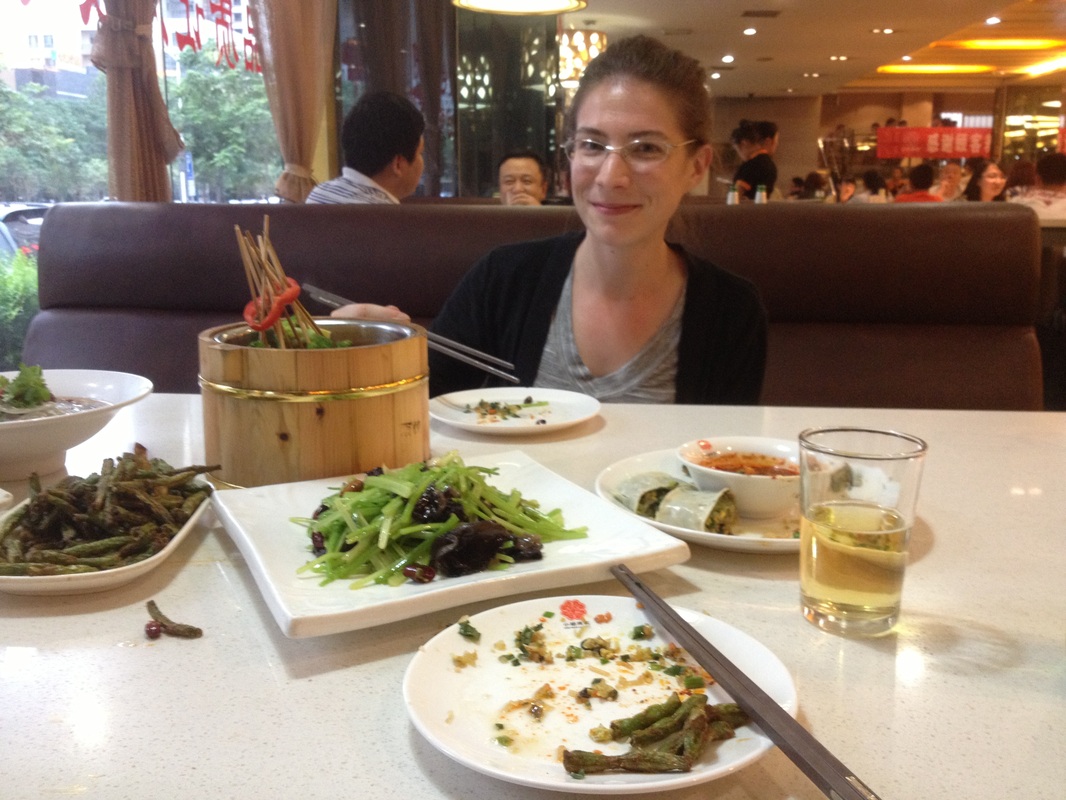 Kate is a chopsticks master. But she taught us well. We only dropped a few things on the table. (Note the stray bean and peanut to the left -- that was all Elizabeth.) Perhaps what's most amazing is that we got all this food -- and two 40-ounce bottles of Tsing Tau -- for the equivalent of about $25. And we have plenty left over for Friday night's meal.
- Ryan
Kate warned us that we'd be gawked at during our time in China considering Westerners are still somewhat rare in parts of China. And she told us we'd likely have our picture taken, as she has numerous times (I'll link to her blog post on the topic just as soon as I'm back in the United States with access to blogspot again. In the meantime, you can visit Orient Orientation and choose Orient Orientation 2 and find it for yourself). Ryan and I didn't feel like most people gave us a second glance in Beijing, but Xi'an has been different. We had our photos snapped by a few groups Thursday as we explored the Shaanxi History Museum, the Giant Wild Goose Pagoda and the surrounding shopping area. Don't get me wrong, it wasn't full-on paparazzi. But it was kind of wild when this gentleman above approached us at the Buddhist Giant Goose Pagoda and asked Ryan in decent English if he would be so kind as to take this snapshot.
Earlier, we had stopped to eat snacks on a park bench when two girls in a small group stopped and started giggling. They first tried to be sneaky about taking photos of us.Then two decided to be brave and ask if their friend could take a picture of the five of us together. We of course said yes. But it didn't occur to us until afterward to take our own picture, leaving Ryan to scramble to get this photo of their backs.
- Elizabeth
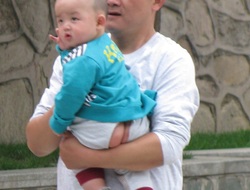 Today's topic is bathroom related, so feel free to skip it if you think it's just TMI. Trust me, I'll understand.
Most babies in China don't wear diapers. They wear pants that are split in the crotch, and their parents hold them up over a bush, a nice grassy area, or somewhere else convenient* when it's time to go. I find this concept fascinating.
We went to a large open-air mall on Thursday, meaning we got to see this phenomenon in action. Well, Ryan is the only one of us who happened to see it in action, if you know what I mean. But I did spot several children wearing these pants and one family cleaning up after a child they didn't get to the grass in time.
This is a topic that has been well documented in the press, and it appears changes are coming slowly.I understand that this practice is environmentally friendly as well as a cultural tradition, but it seems to me that parents would be frequently covered in pee. And so would your belongings. And it totally explains why people here remove their shoes before entering the house, since who would want to track urine everywhere?
As for me, I am so, so happy to live in a society that has embraced the diaper -- whatever kind it is.-Elizabeth *By convenient, Kate says it's just "Wherever they are at that moment." Bonus material - Less sensitive headlines suggested for this post: - No butts about it, urine China now
- Just say no to crack
Among the fruit choices at our breakfast in Beijing on Wednesday were two items neither of us had ever seen.
One was fleshy white melon with black seeds, which I dubbed "dalmatian melon." It had a kiwi-like texture and its flavor was a subtle mix of watermelon and kiwi.
The other tasted like a sweet pear. Its texture and appearance, however, were exactly how I imagine a scooped-out eyeball to be like. Thus, I could not convince Elizabeth to try it.
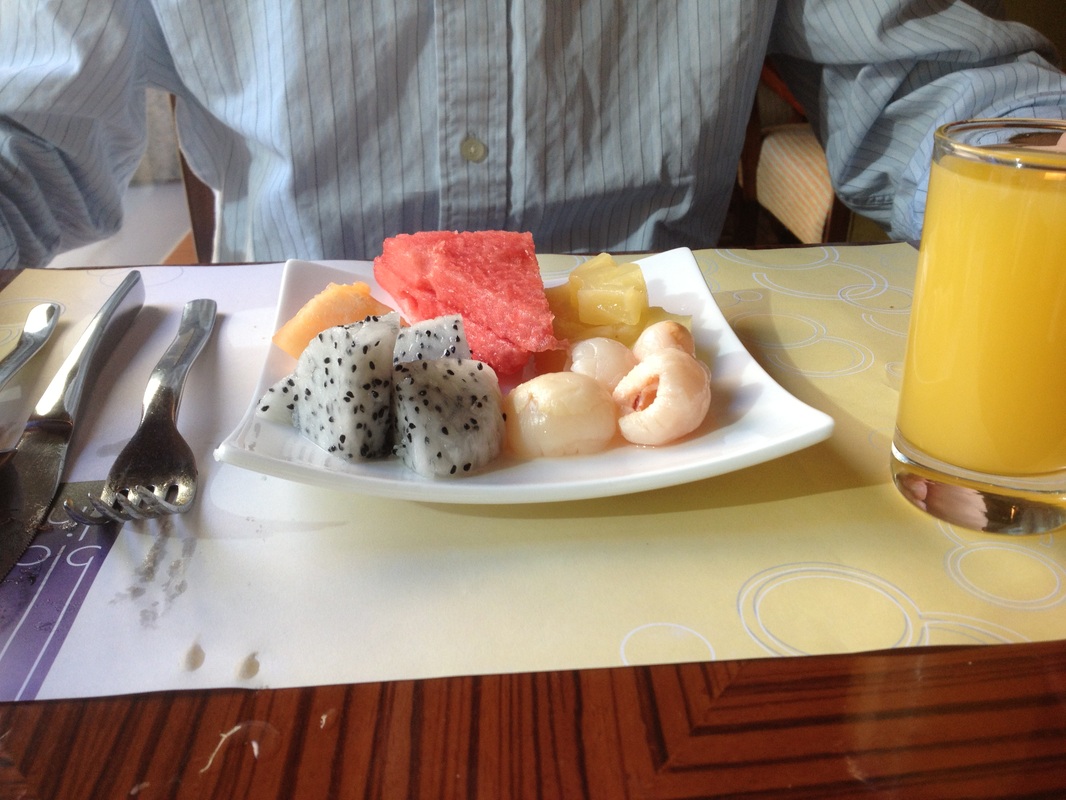
"Dalmatian melon" is on the left and the "eyeball fruit" Elizabeth was too chicken to try is on the right.
These were among the mysteries we were looking forward to having my sister, Kate, solve for us when we arrived in Xi'an. She took us grocery shopping Wednesday night at her local Lotus store, which is like a Meijer with its sections for clothes and other home items in addition to the food.
The "dalmatian melons" are actually dragon fruit, which look even wilder on the outside. The "eyeball fruits" are Lychee. We picked some out and will post a follow-up on how to shell them or peel them or whatever needs to be done to them.
Kate guided us through Lotus, which requires getting all of your fruit and vegetables weighed and stickered at stations in the produce department.
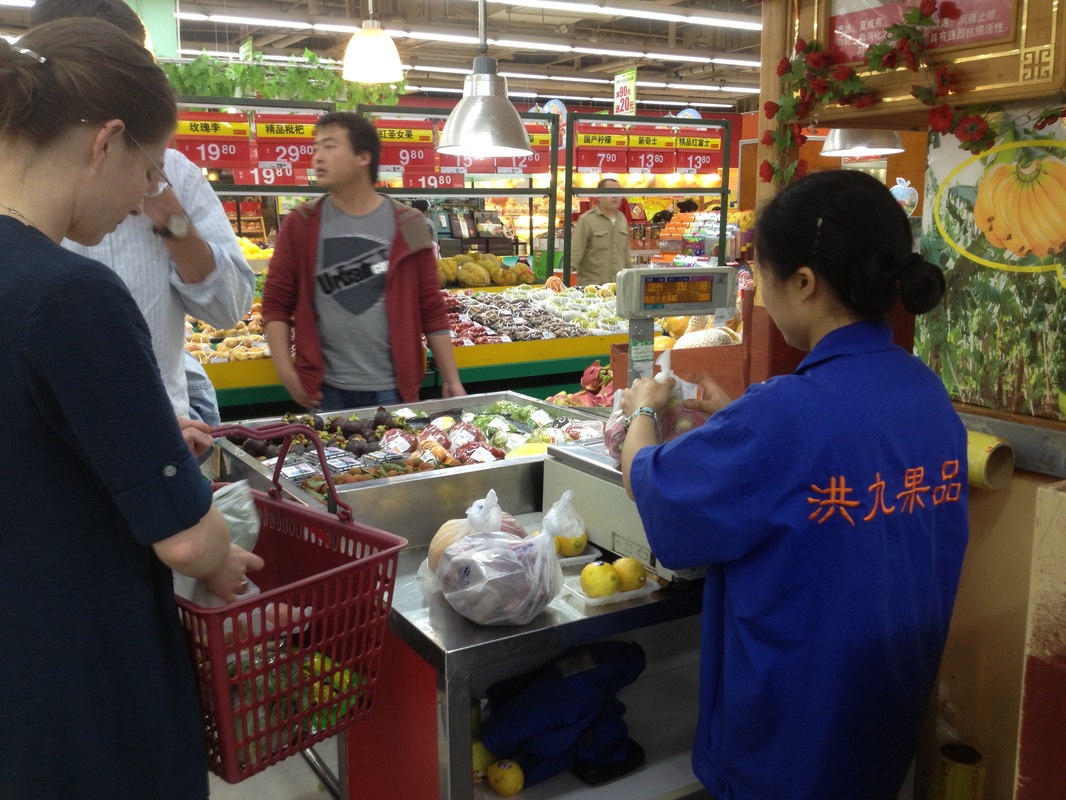
Kate gets her selection of mangos properly stickered.
Grocery shopping in China was another example of the blend we've found between foreign and familiar.
Familiar: the layout, aisle arrangement, bread, most of the vegetables, ice cream (with the exception of flavors like honeydew and green tea -- which we bought to try).
Foreign: Turtles and frogs, milk that's not refrigerated (Kate explained the milk is ultraviolet pasteurized and doesn't need it until opened), dog food-bag-sized containers of rice and an entire section devoted to giant plastic vats of cooking oil.
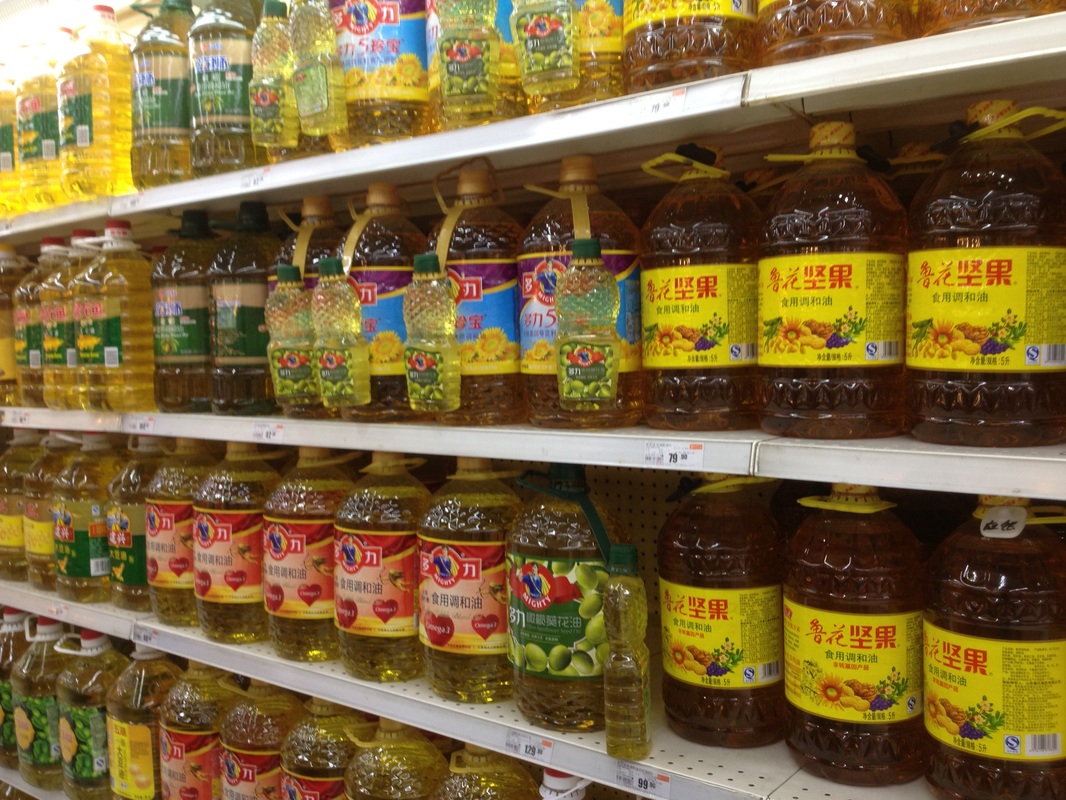
No oil crisis here.
But Elizabeth's favorite section was the tea accessory station. It featured dried lemon slices, dandelions, flower petals, lavender, pieces of tree branches and other unidentified dried stuff. -Ryan
Why don't they have this at Kroger? The dissection station is a staple at this Xi'an grocery store, called Lotus. And here's why it's necessary: Yep, those are frogs and turtles in action that Elizabeth captured with her iPhone on our tour through the grocery store.
We grabbed a flight from Beijing to Xi'an on Wednesday afternoon, and Ryan crossed one item off his bucket list - being greeted at the airport by someone holding a sign with his name on it. A few quick facts on Xi'an: It is the capital of the Shaanxi province and is located about 683 miles from Beijing. In 2010, Xi'an was the country's 14th biggest city with an urban core population of 3.4 million, according to Wikipedia (the most official source I could find, unfortunately). In the past, Xi'an served as the capital for 11 dynasties and was the eastern starting point of the Silk Road. We were going to take an overnight train, but Kate suggested we fly instead because of the difficulty in getting tickets in advance, the extended travel time,and the general discomfort of the train cabins. Not to mention being in a cramped train car for that long with the bird flu threat. The latter was enough reason for me. -Elizabeth
Let me preface this by saying that when we went to London, we were determined not to be "those Americans" who ate at McDonald's.
But in the Chicago airport on Sunday, Elizabeth said, "You know, I'd actually be curious to see what a Chinese McDonald's is like." An hour later, we were standing in line to get our passports and visas checked and started a conversation with the man behind us.
As it happened, Kelvin is an executive with McDonald's and was on his way to meet up with his team in China. He told us that within 10 years, China will surpass the United States as McDonald's largest market. It already has something like 1,400 stores in seven cities. China Daily published an article just last year about McDonald's astounding expansion goal of more than 225 stores per year. And advertising has become more aggressive, as this writer from the China Expat blog observed.
Still, it's second to Kentucky Fried Chicken, the flagship brand of the Louisville-based Yum! Corp. Several news organizations have written about KFC's domination of the Chinese markets.
But here's where it gets interesting. Kelvin told us that one of the reasons McDonald's was slow to get a foothold in China was that it spent four years setting up a supply-chain infrastructure. For instance, there were no potato farms in China before McDonald's arrived in 1990. Imagine that -- no fries with that. Beef also wasn't big. So McDonald's essentially had to help launch a beef cattle industry in China. It also set up its own supply chain for chicken using farming standards of the U.S. poultry industry.
Thus, when China was hit with an outbreak of bird flu, McDonald's didn't lose a step, Kelvin said. KFC, however, has relied on a traditional network of chicken suppliers and the restaurant chain has taken quite a hit, as the Associated Press reported.
Kelvin also told us that the menu was essentially the same as American fare but with some regional specialties. That sealed it for us. So for lunch on Tuesday, we found the McDonald's at the Wangfujing shopping area.
Ordering was the toughest part. The cashier was not impressed with my rudimentary Mandarin, so she bailed me out with her rudimentary English and got our orders largely correct: a chicken sandwich meal for Elizabeth and a rice patty and chicken wrap (one of those regional specialties) for me. I say "largely correct" because we were each given Cokes without a choice.
Oh, and that wrap? It's the best thing I've ever eaten at McDonald's. -Ryan
Ryan is always navigator-in-chief in our household, but he outdid himself Tuesday on our first day in Beijing. He got us all three places we wanted to go with only a few hiccups.
Kate had warned us about a few basic travel quirks before we arrived:
1. Maps aren't really to scale. To get around this, Ryan sketched out his own maps in a Moleskine journal (he wisely agreed that it was best not to bring any reporter notebooks with him this time).
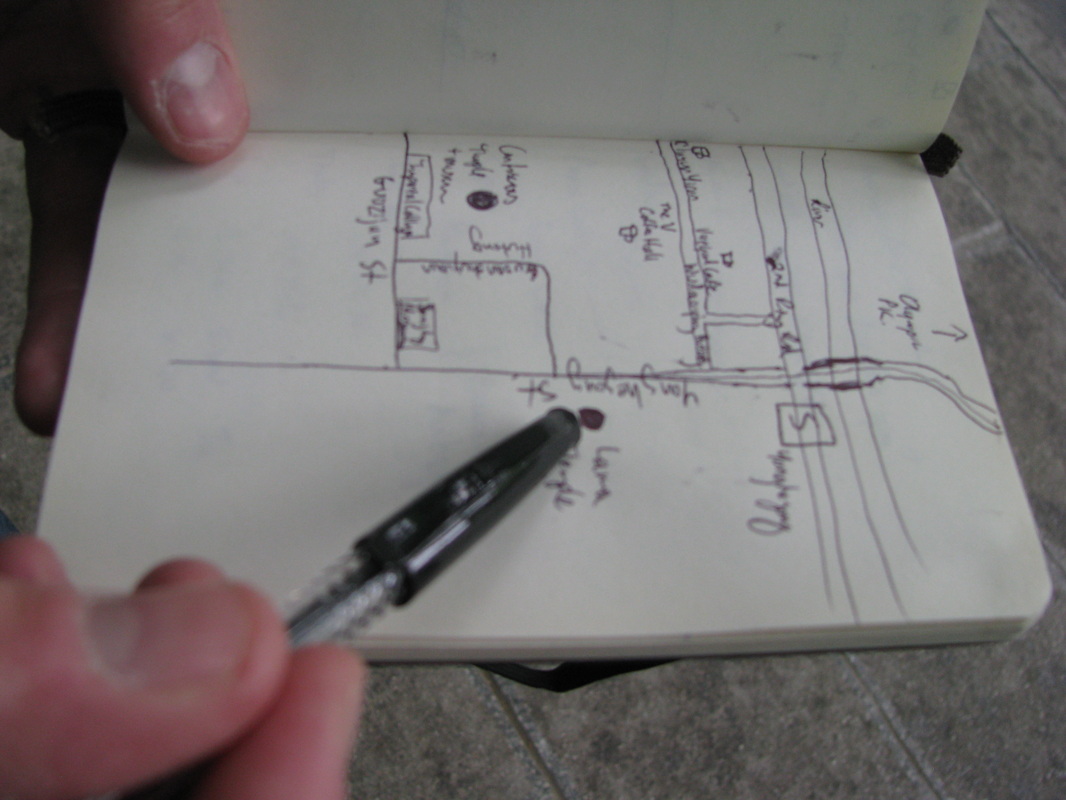
Ryan's sketch of the area around the two temples we visited Tuesday morning.
2. Traffic laws are either non-existent or not enforced. Therefore, Kate advised us to cross the streets with extreme caution and with large groups whenever possible. Trusting the crosswalk signs is more of a suggestion you can try after all the turning cars and bikes have passed. At one point, we had to jump out of the way after a car turned onto the sidewalk where we were walking. Even with Kate's warning, we were shocked by how truly terrible it is. Unsurprisingly, we found this fact in a Washington Post story: 220,000 traffic fatalities every year in China with a third as many cars as the United States.

As you can see, bikes and cars don't really yield to pedestrians. About 10 seconds later, that bus on the left nearly took out three bikers. We have yet to see a helmet on a bike or scooter rider.
We can add a No. 3 to this list - the subway is pretty easy to use as a foreigner. Not that we were without any problems: The in-service subway ticket machine didn't work in either station we tried and there are metal detectors that bags must pass through before entering the station. But signs and announcements were done in English as well as Mandarin, and the non-working ticket machines even had an English option. It was much more accessible to foreigners than the subway in Paris. If you don't speak French in Paris, they don't really seem to care if you find your destination OK.
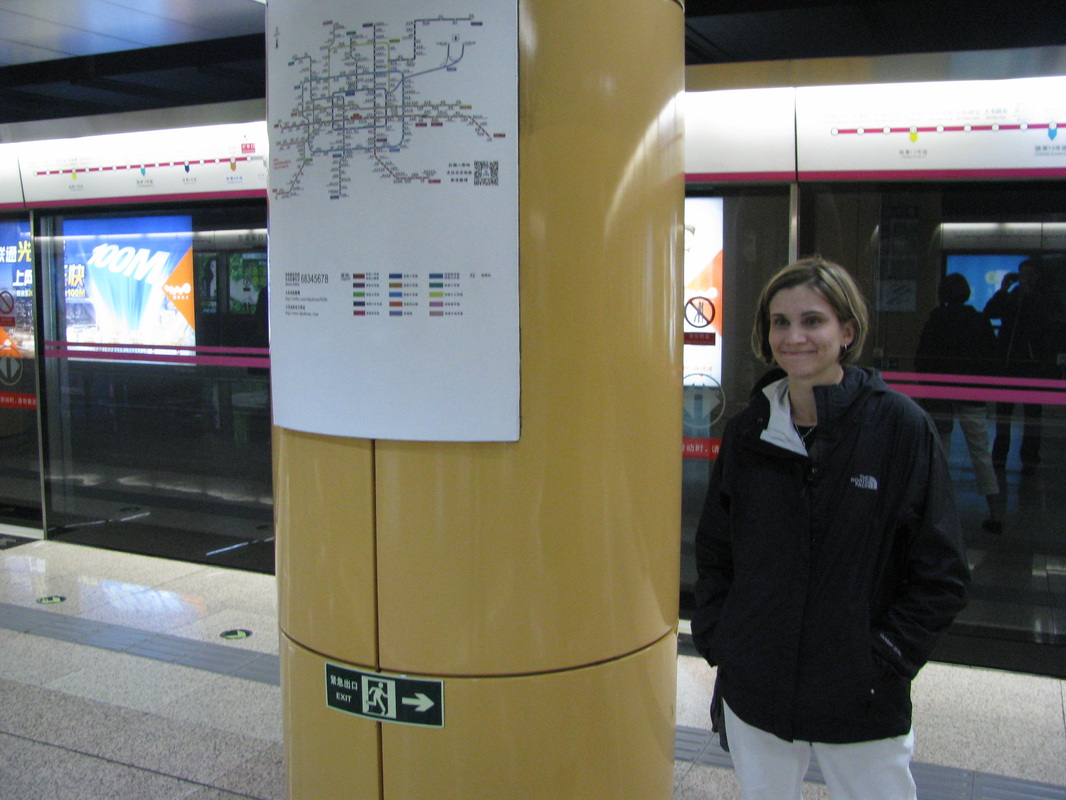
Considering that Ryan had to do all of the work to get us there, I'm not sure why I ended up photographed in front of the subway map.
Faithful readers, i.e. our parents, may notice that the horrid green raincoat has been replaced with a nice black one this year. Unfortunately it wasn't purely a fashion choice; it rained most of the day Tuesday.
-Elizabeth
To shake off the jetlag and get acclimated to Beijing, Elizabeth and I spent our first full day in China seeking enlightenment and knowledge at two of the oldest and most important temples in the city.
The Lama Temple is the oldest and best-preserved Buddhist temple in Beijing. It's ornate. Gilded Buddha statues of all sizes can be found in the various palaces, halls and pavilions. None is more impressive than the three-story high Buddha Maitreya (the incarnation of Buddha on earth) carved out of a single piece of sandalwood and decorated in gold. No photos were allowed in that area. Strangely, neither the audio tour nor the signs throughout the temple mentioned that in the past, foreigners would disappear when visiting the temple, which was out of bounds for most Beijing residents. Those disappearances, according to National Geographic, fueled rumors of human sacrifices.
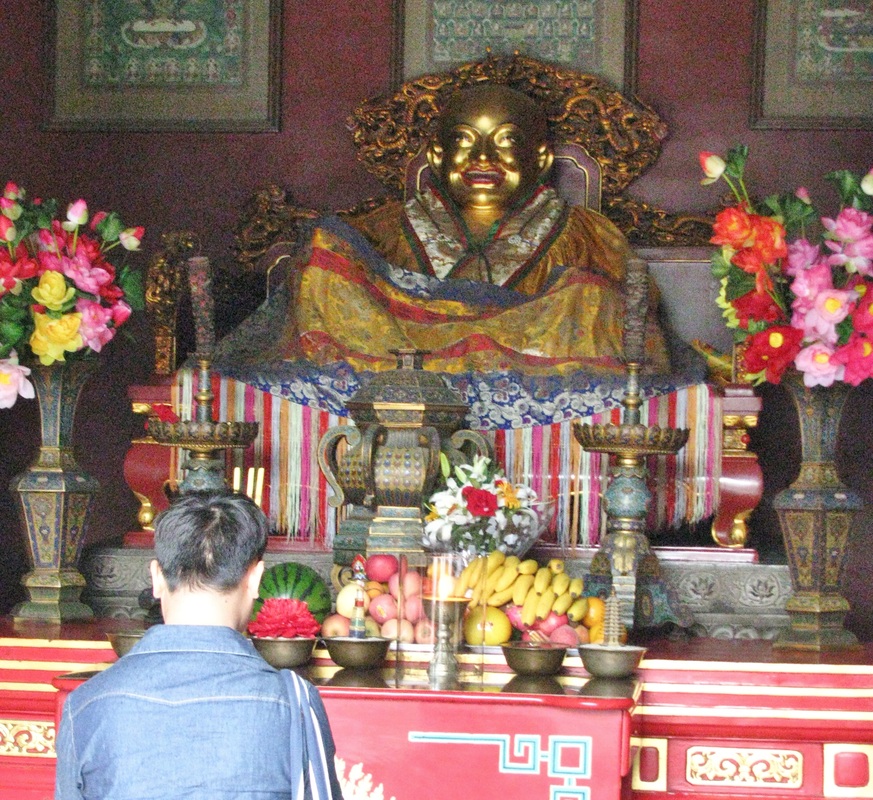
Laughing Buddha.
Incense and Sensibility -- Buddhist monks still worship at the temple from 5 a.m. to 7 a.m. Even during public hours, scores of people were paying homage to Buddha by bringing offerings of fruit and burning incense outside the various palaces and halls. In fact, the whole experience smelled very much like my freshman year in college.

Burning incense outside the first worship hall at Lama Temple.
Duck for luck -- Like any tourist/pilgrim destination, the Lama Temple had a number of offering stations where people could donate money. One was a cylindrical metal cage in which people tried to toss coins in the top for luck. Here's a broad generalization: Chinese people have bad aim. Either that, or the Buddhists have employed an invisible Anthony Davis to block the shots. No one we saw could get a coin in. And because there was no back stop and it was in the round, people on the opposite side of the tosser would get pelted. At one point I took a jiao (which is like a dime) to the shoulder.
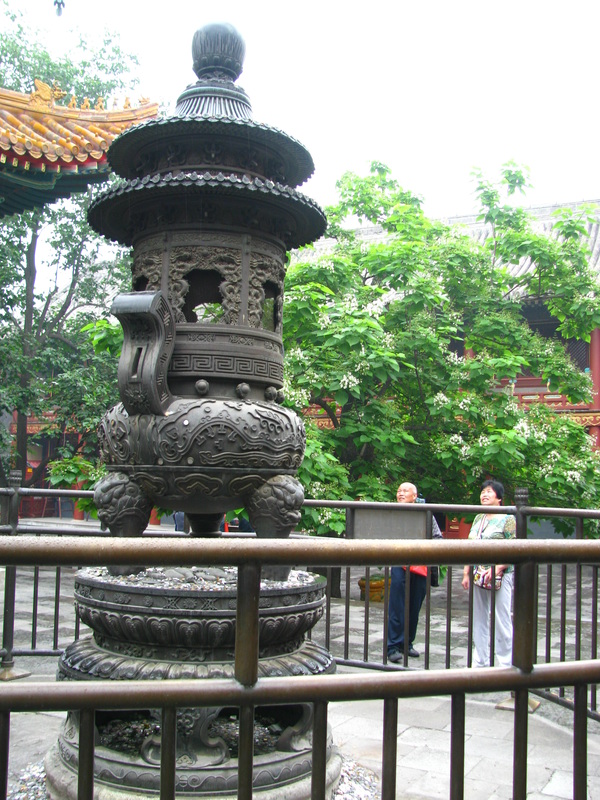
A gentleman trying his luck.
Down the street from the Lama Temple is the Confucius Temple and the Imperial College where aspiring government officials went to study for centuries.
To our untrained eyes, the architecture and ornaments on the Confucius Temple buildings looked suspiciously similar to the Lama Temple. We did not ask for our money back.
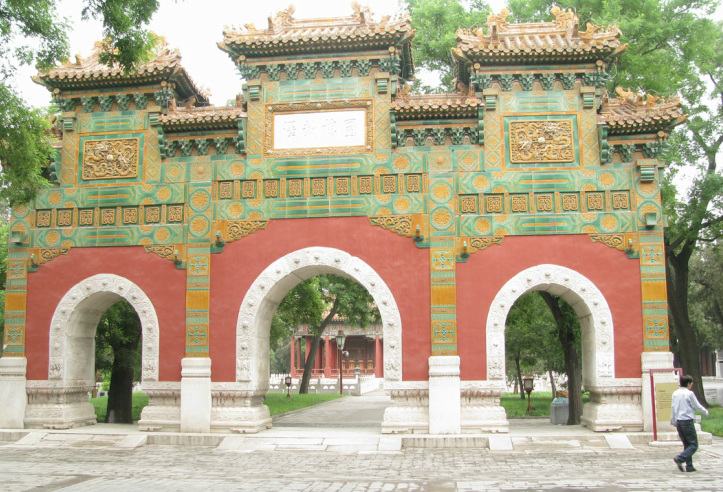
The Glazed Memorial Arch in front of Imperial College.
The temple featured lots of stone tablets. One calligrapher spent 12 years carving 630,000 Chinese characters into more than 100 such stone tablets that looked like oversized grave stones. In fact, walking through that building offered what I imagine would be a rabbit-eye view of a cemetery.
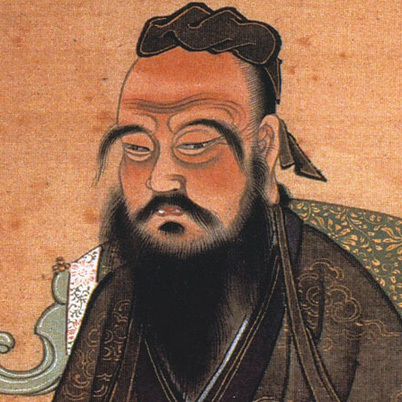
Image of Confucius from Biography.com.
Confucius himself was much more interesting to me now than he was during 10th grade social studies. Born in 551 B.C. to an aristocratic family that hit hard times, Confucius went from being a music loving clerk to starting his own private school -- something that was unheard of for a non-government official. Among his lessons that should still apply (and are still being ignored) today: - "It's important for a king to restrict public expenses."
- "Rule with virtue"
- "Harsh government is even tougher than tigers" (That, according to legend, is literal. He was said to have met a woman weeping by a tomb. She told Confucius three generations of her family had been killed near their mountain home by a tiger. When he asked why the family didn't move, she replied that she was more afraid of the oppressive government in the village.)
- And my personal favorite: "Don't be conceited."
Confucius also has a sense of humor. Here he is photo bombing us. -Ryan
|



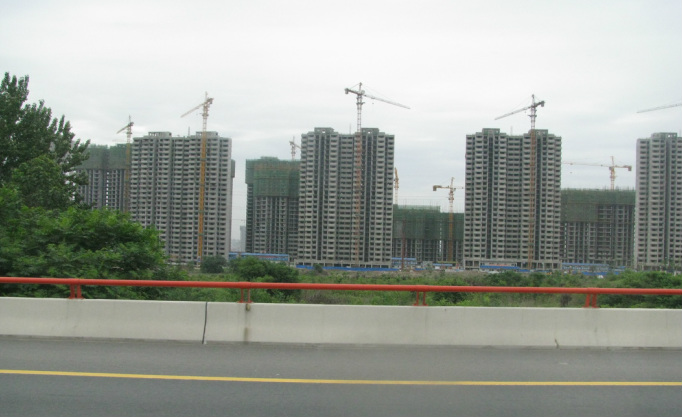




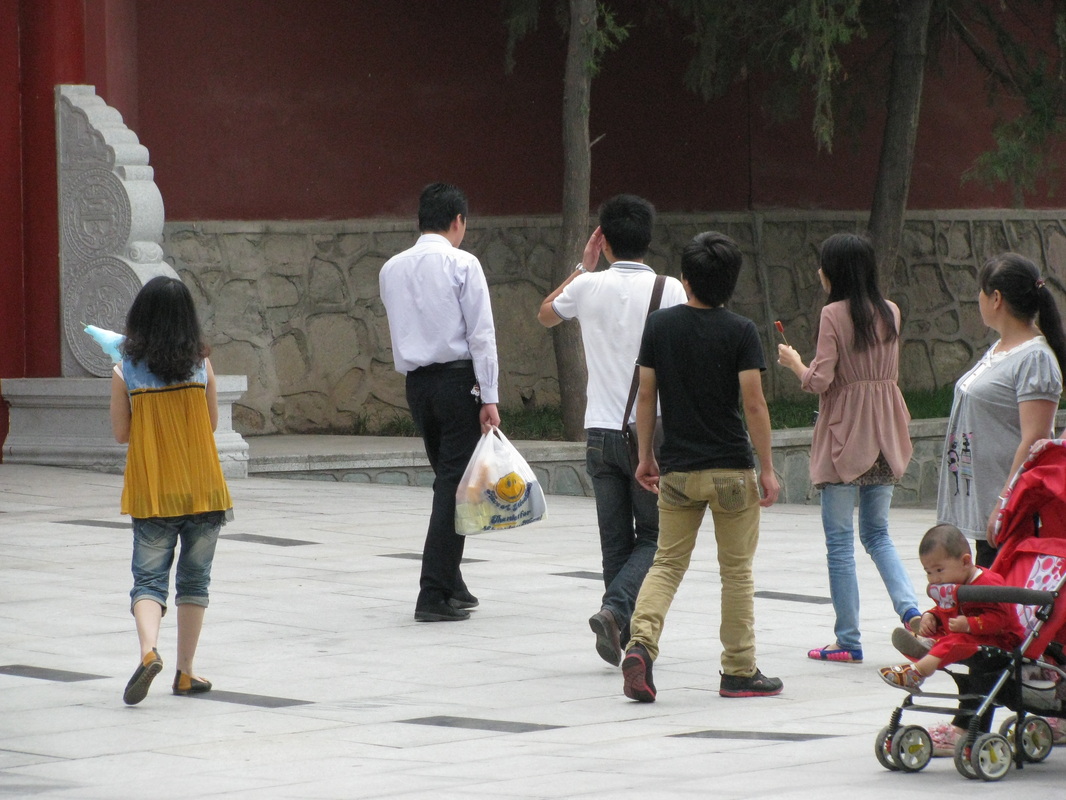

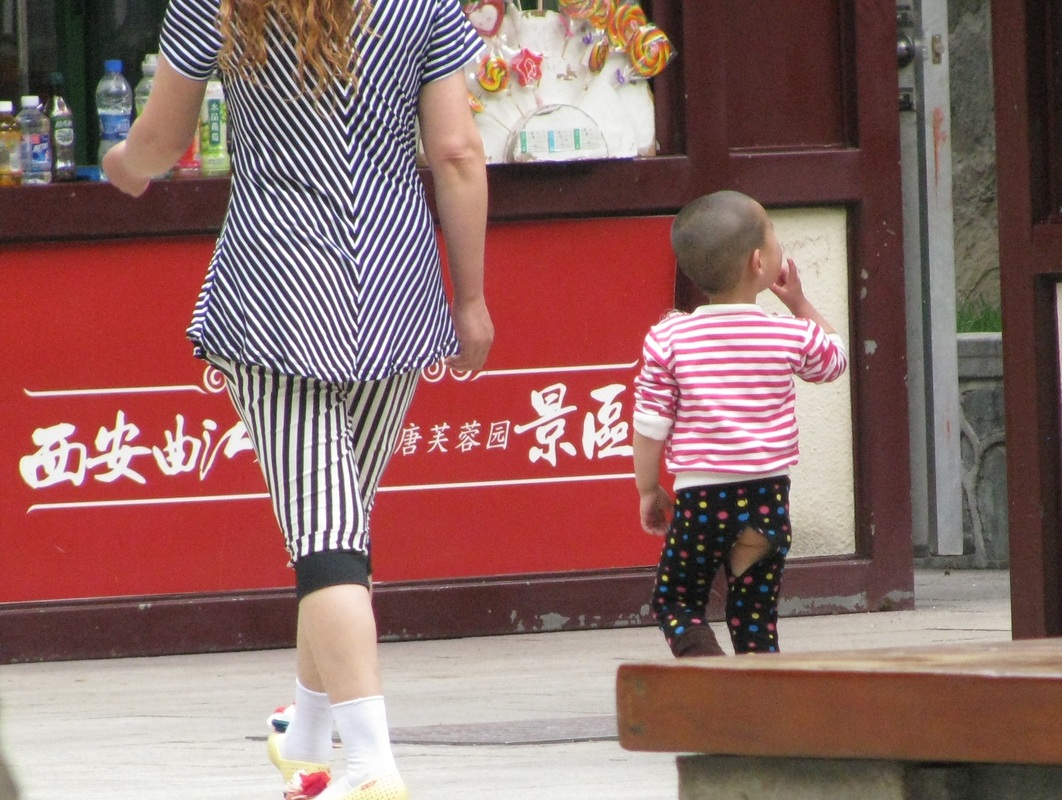



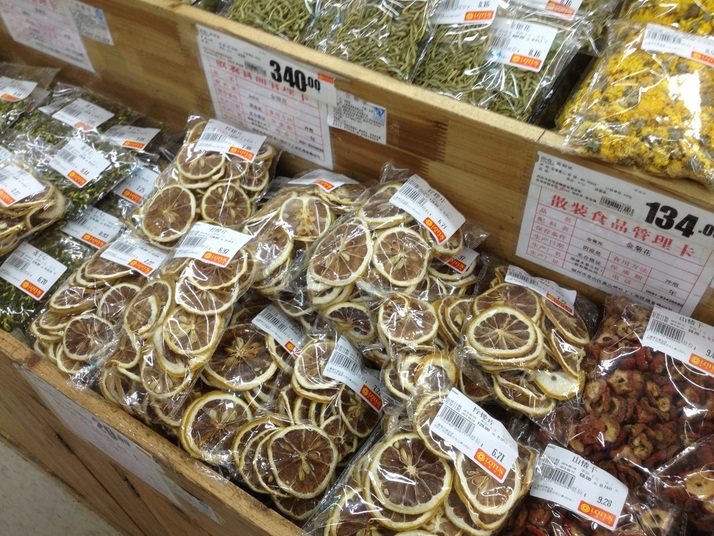
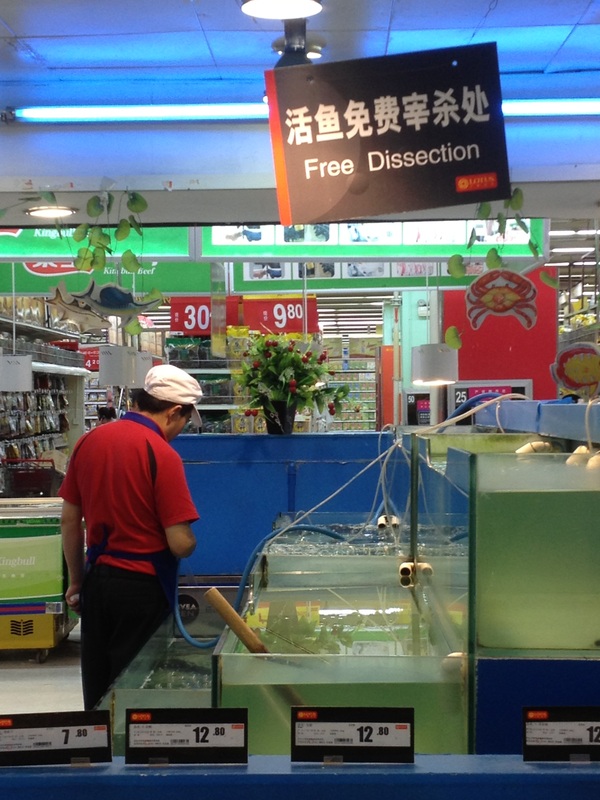
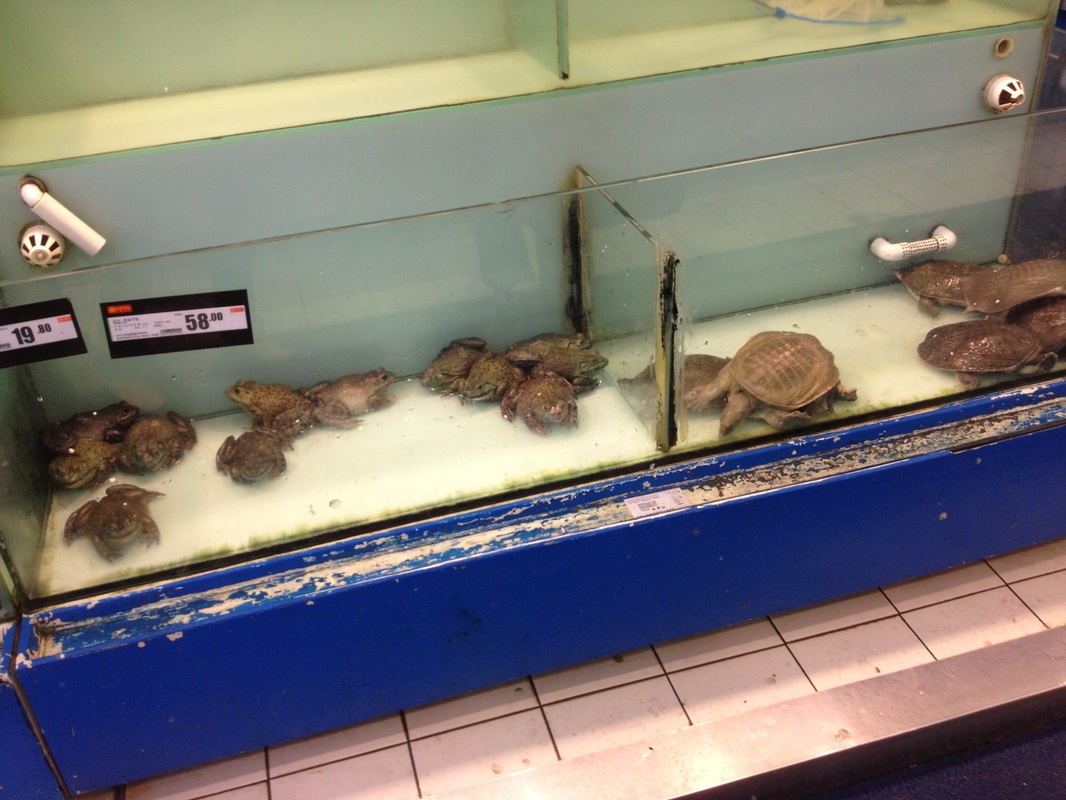

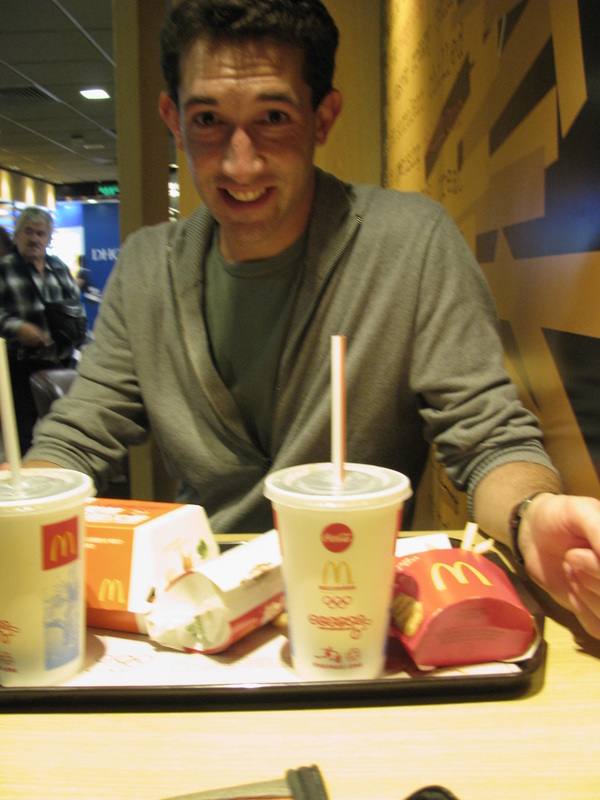



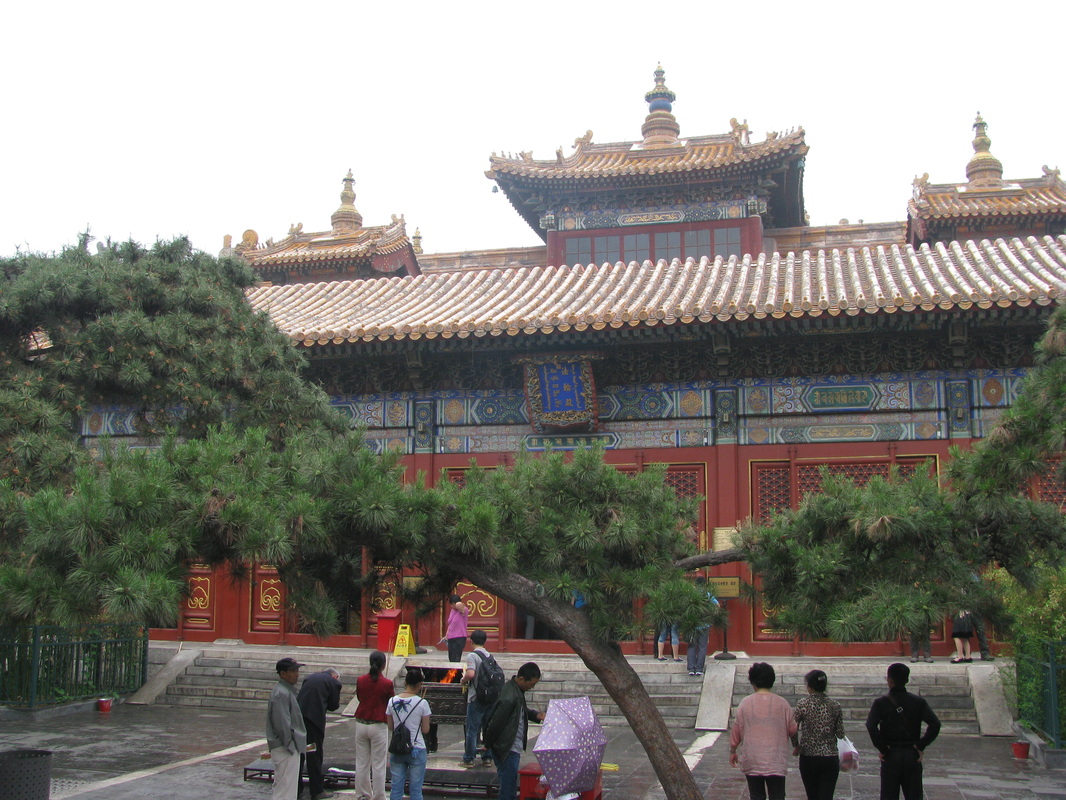






 RSS Feed
RSS Feed